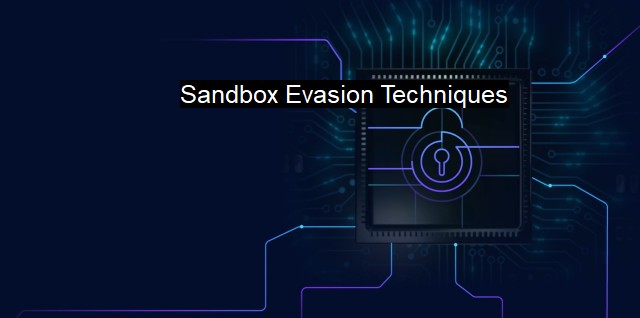What are Sandbox Evasion Techniques?
Unraveling the Latest Cybersecurity Threat: Evolving Sandbox Evasion Techniques
Sandbox evasion is a cybersecurity concept that refers to various techniques used by cybercriminals to evade detection from sandboxing technology. Sandboxing is a software management strategy that isolates applications from critical system resources and other programs. It provides an extra layer of security that prevents malware or harmful applications from negatively affecting your system. The isolation of a specific application prevents threats from spreading onto the wider system.Sandbox evasion techniques have been developed by hackers to bypass or manipulate these security measures. These techniques involve tactics that detect the presence of a sandbox, delay execution until the malware is outside the sandbox, or use commands and instructions that the sandbox is unaware of or not designed to handle.
One of the most common sandbox evasion techniques is environment checking. When a harmful application or piece of malware is introduced onto a system, it checks for certain characteristics consistent with a sandbox environment before executing. Many sandbox environments have unique attributes that aren't typically present in traditional operating systems. So, if these attributes are detected by malicious software, it will either behave benignly or lay dormant to avoid detection.
Another well-used evasion technique by cyber-attackers is time-based evasion. In this case, the malicious code delays its execution. Sandbox designs generally monitor software behavior for a limited period of time, and by postponing the execution of harmful commands, malware can often avoid detection in this timeframe. Then, when its 'sleep' period ends and the sandbox isn't monitoring anymore, the malware executes the actual damaging commands.
The utilization of obscure instructions or a programming language is another popular technique to escape detection. It includes the use of lesser-known commands and instructions that sandbox may not recognize or have handling procedures for. encoded or hidden commands in software often go undetected by antivirus systems that use sandboxes.
Hackers often use sophisticated evasion technique referred to as a recompiling attack, in which attackers change the code of a malicious file in such a manner that its digital or binary signature becomes unrecognizable to the defensive systems.
Importantly, the rapid growth of sandbox evasion techniques poses challenges to existing cybersecurity strategies. There is a constant cat-and-mouse game between hackers devising new ways to elude security systems and cyber-defenders upgrading and updating their sandboxing technologies to prevent such evasion. As a result, it is essential for those involved in cybersecurity not just to implement sandbox security measures but also to understand and stay informed about evolving evasion techniques.
Effective sandboxing strategies are evolving to deal with these evasion tactics. Tactics include incorporating environmental randomness, where the characteristics of the sandboxing environment are constantly changing, making familiarity hard for malware. This approach decreases the likelihood that harmful software will be able to detect the sandbox and either change its behavior or go dormant.
Strategies are in place that deploy multi-layered security architectures that can catch malware that has learned to evade sandbox detection. Many of today's advanced, big-data cybersecurity systems monitor network traffic at all times rather than during prescribed periods, countering delayed executions.
Employing a hybrid architecture featuring a host and network-based sandbox methods, effectively counters many evasion techniques. New developments in the field of machine learning and AI are used widely to assist sandboxing capacities and detect anomalies effectively.
The scale and complexity of the problem underline the importance of constant vigilance in today's digital world. Cybersecurity is a constant battle between malicious hackers and cyber-defenders, with both sides continually attempting to outmaneuver the other. As such, understanding sandbox evasion techniques is crucial in the fight against cybercrime.

Sandbox Evasion Techniques FAQs
What are sandbox evasion techniques?
Sandbox evasion techniques are methods used by cybercriminals to bypass or evade the security measures put in place by antivirus software or sandboxes. These techniques are employed by attackers to avoid detection and analysis by security solutions.What are some common sandbox evasion techniques?
Some common sandbox evasion techniques include code obfuscation, anti-analysis techniques, fileless malware, polymorphic malware, and techniques that leverage legitimate processes to hide their malicious activities.How can organizations protect themselves from sandbox evasion techniques?
Organizations can protect themselves from sandbox evasion techniques by employing a multi-layered security approach that includes advanced threat detection solutions, network traffic monitoring, regular security updates, and user awareness training.Why is it important to be aware of sandbox evasion techniques?
It is crucial to be aware of sandbox evasion techniques because they pose a serious threat to an organization's security posture. By understanding these techniques, security professionals can implement appropriate countermeasures to prevent cyber attacks and minimize the damage caused by successful attacks.| | A | | | B | | | C | | | D | | | E | | | F | | | G | | | H | | | I | | | J | | | K | | | L | | | M | |
| | N | | | O | | | P | | | Q | | | R | | | S | | | T | | | U | | | V | | | W | | | X | | | Y | | | Z | |
| | 1 | | | 2 | | | 3 | | | 4 | | | 7 | | | 8 | | |||||||